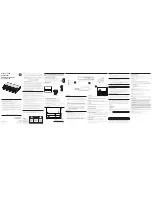
Problem
Solution
The link indicator light is off.
l
Run the adapter and network tests described in
Testing
the Adapter
.
l
Make sure you have loaded the adapter driver.
l
Check all connections at the adapter and the switch.
l
Try another port on the switch.
l
Make sure the cable is securely attached. Also make
sure that it is the proper type and does not exceed the
recommended lengths.
l
Make sure the link partner is configured to auto-nego-
tiate (or forced to match adapter).
l
Verify that your switch is compatible with your network
adapter port.
The link light is on, but communications are not
properly established.
l
Make sure the proper (and latest) driver is loaded.
l
Both the adapter and its link partner must be set to either
auto-negotiate or manually set to the same speed and
duplex settings.
NOTE:
The adapter's link indicator light may be on even if
communications between the adapter and its link partner
have not been properly established. Technically, the link
indicator light represents the presence of a carrier signal
but not necessarily the ability to properly communicate
with a link partner. This is expected behavior and is con-
sistent with IEEE's specification for physical layer oper-
ation.
The diagnostic utility reports the adapter is "Not
enabled by BIOS."
l
The BIOS isn't configuring the adapter correctly.
l
Try another PCI Express slot.
The server hangs when the drivers are loaded.
l
Change the BIOS interrupt settings.
Adapter unable to connect to switch at correct
speed (copper wiring only).
This is applicable only to copper-based connections.
l
Try another cable.
l
Make sure the cable is Category 5 or 5e.
l
Make sure the link partner is set to auto-negotiate.
l
Verify that your switch is compatible with your network
adapter port and that you are running the latest oper-
ating system revision for your switch.
The device does not connect at the expected
speed.
When Gigabit Master/Slave mode is forced to "master" mode on
both the Intel adapter and its link partner, the link speed
obtained by the Intel adapter may be lower than expected.
After upgrading operating systems, Intel PROSet
is no longer available.
If you are upgrading Windows operating systems and you have
Intel PROSet software installed, it will be deleted in the process.
You will need to reinstall Intel PROSet.
Hardware tests fail in Intel PROSet, DIAGS, Dell
OpenManage Server Administrator, or ethtool.
A component on the adapter is not functioning correctly.
Try another adapter. If the test fails with the replacement
adapter, there might be problem with the system board, or
another device on the bus might not be functioning correctly.
Contact
Customer Support
for more information.
















































